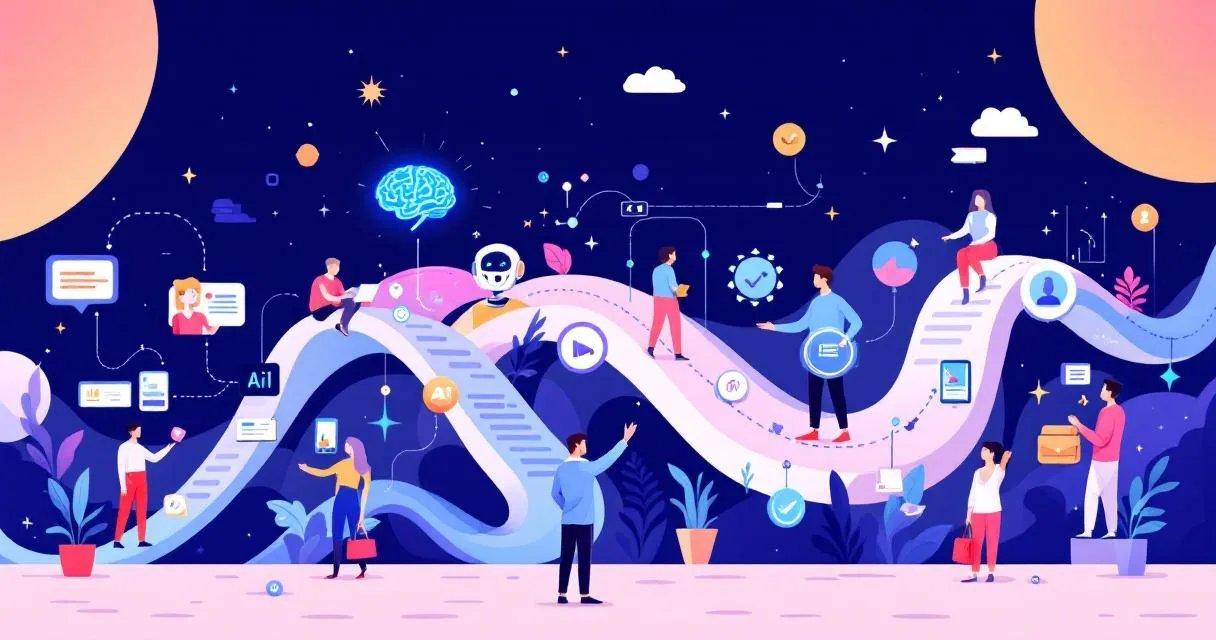In today’s fast-moving digital marketing and customer experience, customer journey mapping has now undoubtedly become one of the major tools with which businesses try to understand, analyze, and improve user experiences. This strategic visualization helps companies view the sight of their customers — from first awareness to purchase and beyond.

In this article, we want to provide you with an all-inclusive overview of what customer journey mapping is, why it matters, how to create a map with impact, and how customer journey mapping can change business outcomes. Whether you are a digital marketer, UX designer, or business owner, this article should provide valuable insight into how you can leverage customer journey mapping.
What is Customer Journey Mapping?
Customer journey mapping is the art of creating a graphical representation of every experience the customers have with the brand. This involves different touchpoints, channels, and stages of the buyer’s journey from the time the customer discovers the business until after the purchase is made for support and loyalty.
Typically, maps show:
Customer actions
Emotions
Pain points
Interactions
Channels
By mapping this journey, customers can pinpoint friction elements, happy occasions, and how internal processes can be best aligned in order to present seamless and personalized experiences.
Why is Customer Journey Mapping Important?
1. Empathy-Focused
Essentially, mapping the journeys of your customers through the services you provide shifts the perspective from a business to a customer perspective. Knowing what a customer feels, needs, or wants instills empathy and provides a very valid basis for creating more meaningful and successful strategies.
2. Identifying Pain Points
A journey map can outline a path to gain information on issues arising at a variety of touchpoints-from confusing checkout processes to lack of communication post-sale-and these weak points could be identified and tackled way ahead.
3. Improved Customer Retention
When you understand the journey, you’re better equipped to optimize it into something better. Better satisfaction is a gift that leads to loyalty and lateness.
4. Aligns Teams Towards a Co-created Vision
Generally, sales, marketing, customer service, and product development are led by their own insights about the customer. Customer journey mapping channels these views into a single view; hence, cross-functional alignment is guaranteed.
Major stages in the customer’s journey
A good customer journey mapping exercise does need a good understanding of the typical stages present in the journey.
1. Awareness
This is the stage when a customer first becomes aware of your product or service, largely via some form of ad, social media platform, blog post, or referral.
2. Consideration
Now the customer is considering whether your offering would meet their needs. They may go to your website, check your reviews, or compare you against your competition.
3. Decision
The actual purchasing of the product is made during this stage, so the experience during this phase must go through without a single hitch and reassure.
4. Retention
Communication after purchase, along with customer support and active involvement, is crucial. The right retention strategy builds loyalty.
How to Create a Customer Journey Map
The development of a customer journey mapping process consists of numerous steps. Here is a detailed guide:
Step 1: Clearly Define Your Objectives
Identify a specific goal: What is the aim? Is it to increase conversions, improve onboarding, or reduce churn? The purpose defines the bounds of the map.
Step 2: Buyer Personas
Next, flesh out real personas that include those who will be creating your customer journey map. Describe the demographics, goals, behavioral patterns, and challenges.
Step 3: Touchpoints
List all those touchpoints their customers have with your brand: website, emails, phone, social, and many more.
Step 4: Mapping the Stages
Stage the journey into steps: awareness, consideration, decision, etc.; specify actions, thoughts, and feelings in each of these steps.
Step 5: Data Gathering and Feedback
Gather customer’s voice: feedback, analytics, CRM data, support tickets, etc., in order to validate and enrich your map.
Step 6: Pain and Gap Detection
Look for pain points and areas of improvement. Are customers lost at any key stage? Does support take longer than required to reach?
Step 7: Improve and Iterate
Apply insights from the map to enhance the journey with, for example, simplification in the onboarding process or personalization of communications.
Tools for Customer Journey Mapping
Following are a few popular tools that make customer journey mapping less complex and more effective:
Smaply: Persona templates, journey mapping, and stakeholder mapping.
Lucidchart: Very useful for creating visual flowcharts and maps.
Miro: An online whiteboard platform perfect for distributed teams.
UXPressia: Specific design for customer journey mapping and persona creation.
Canvanizer: Simple basement using drag and drop for agglomerating business models and customer journeys.
E-commerce customer journey: real example
Suppose you run an online fashion store. The customer journey mapping here for your e-commerce would be something like:
Awareness Stage
A customer sees an ad on Facebook for summer dresses.
Clicks on the ad to go to the home page.
Consideration Stage
Browse product categories.
Customer reviews read and blog posts.
Subscribe to the newsletter and get a discount.
Decision Stage
Items added to the cart.
Discount applied; nothing else left to purchase.
Receives email telling that it was confirmed order.
Retention Stage
Gets delivery tracking updates.
Fresh post-purchase survey.
Gets a follow-up email suggesting matching accessories.
Advocacy Stage
Post an image on Instagram tagging the brand.
Written a positive review.
Refers a friend with a referral code.
This whole picture gives the opportunity to optimize every phase, from the targeting of the advertisement down to loyalty programs.
Common Challenges in Customer Journey Mapping
Customer Journey Mapping has numerous advantages and merits, yet some challenges too.
1. Limited Data Access Incomplete or fragmented data could well prevent very accurate map construction with this method. Integrate your CRM systems, analytics, and support to obtain holistic views.
2. Multiple Personas Too overwhelming to try and map all those journeys at once. Start with a central persona, and work your way outwards from there.
3. Static Maps This by no means should be the end of it; regularly update it with fresh new data, as the behavior of customers changes.
4. No Internal Buy-in If even departments don’t want to see the point of customer journey mapping in an organization, then implementation will prove difficult. Showing impact by quick wins and insights helps. B2B Customer Journey Mapping vs. B2C Customer Journey Mapping Whereas the principles are similar, the customer journey maps are quite different between B2B and B2C customers. B2B journeys involve long-term and multi-stakeholder involvement. The decision process is often very rational rather than impulsive.
5. The B2C journeys are fast and emotional. Factors such as branding, visuals, or social proof take a bigger part. Examples include webinars, demos, and sales meetings, which are important touchpoints in B2B. Reviews, ads, and influencers produce a bigger impact in B2C. Benefits of a Customer Journey Mapping Here is a quick summary of some of the key benefits of customer journey mapping: Improvement of the customer experience Increase in Conversion Rate Retention Reduces Discovery with product development Increase of customer lifetime value Alignment of Marketing, Sales, and Support Departments Future of Customer Journey Mapping in Ageing Customer journey mapping is ever becoming more dynamic and forecast with rising AI, Machine Learning, and real-time analytics. Such tools are now able to render businesses aware when behaviors have occurred with real-time tracking.
6. Future expectations include:
Journey Mapping by Predictions: Combining with Chatbots and AI Assistants: Hyper-personalized based on Individual Behavior Omnichannel journey maps across devices and platforms Conclusion IN Thus, in a nutshell, CJM provides companies with a well-thought-out and-even more important-data-driven grasp of what customers want and feel, therefore eliminating unnecessary friction and replacing crummy or irrelevant experiences with higher-quality ones. By investing time and effort in journey mapping, conversions will only increase, but you will invest in long-term relationships based on empathy and trust. This is customer journey mapping; whether starting or refining your customer experience strategy, it promises to be the most effective tool for growing, pleasing, and retaining customers.
7. Advocacy Happy customers turn into advocates for your brand. They will soon start spreading the word about their good experiences while referring others to your business.
